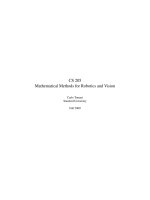CS 205 Mathematical Methods for Robotics and Vision docx
Bạn đang xem bản rút gọn của tài liệu. Xem và tải ngay bản đầy đủ của tài liệu tại đây (481.7 KB, 99 trang )
CS 205
Mathematical Methods for Robotics and Vision
Carlo Tomasi
Stanford University
Fall 2000
2
Chapter 1
Introduction
Robotics and computer vision are interdisciplinary subjects at the intersection of engineering and computer science.
By their nature, they deal with both computers and the physical world. Although the former are in the latter, the
workings of computers are best described in the black-and-white vocabulary of discrete mathematics, which is foreign
to most classical models of reality, quantum physics notwithstanding.
This class surveys some of the key tools of applied math to be used at the interface of continuous and discrete. It
is not on robotics or computer vision. These subjects evolve rapidly, but their mathematical foundations remain. Even
if you will not pursue either field, the mathematics that you learn in this class will not go wasted. To be sure, applied
mathematics is a discipline in itself and, in many universities, a separate department. Consequently, this class can
be a quick tour at best. It does not replace calculus or linear algebra, which are assumed as prerequisites, nor is it a
comprehensive survey of applied mathematics. What is covered is a compromise between the time available and what
is useful and fun to talk about. Even if in some cases you may have to wait until you take a robotics or vision class
to fully appreciate the usefulness of a particular topic, I hope that you will enjoy studying these subjects in their own
right.
1.1 Who Should Take This Class
The main goal of this class is to present a collection of mathematical tools for both understandingand solving problems
in robotics and computer vision. Several classes at Stanford cover the topics presented in this class, and do so in much
greater detail. If you want to understand the full details of any one of the topics in the syllabus below, you should take
one or more of these other classes instead. If you want to understand how these tools are implemented numerically,
you should take one of the classes in the scientific computing program, which again cover these issues in much better
detail. Finally, if you want to understandrobotics or vision, youshould take classes in these subjects, since this course
is not on robotics or vision.
On the other hand, if you do plan to study robotics, vision, or other similar subjects in the future, and you regard
yourself as a user of the mathematical techniques outlinedin the syllabus below, then you may benefit from this course.
Of the proofs, we will only see those that add understanding. Of the implementation aspects of algorithms that are
available in, say, Matlab or LApack, we will only see the parts that we need to understand when we use the code.
In brief, we will be able to cover more topics than other classes because we will be often (but not always)
unconcerned with rigorous proof or implementation issues. The emphasis will be on intuition and on practicality of
the various algorithms. For instance, why are singular values important, and how do they relate to eigenvalues? What
are the dangers of Newton-style minimization? How does a Kalman filter work, and why do PDEs lead tosparse linear
systems? In this spirit, for instance, we discuss Singular Value Decomposition and Schur decomposition both because
they never fail and because they clarify the structure of an algebraic or a differential linear problem.
3
4 CHAPTER 1. INTRODUCTION
1.2 Syllabus
Here is the ideal syllabus, but how much we cover depends on how fast we go.
1. Introduction
2. Unknown numbers
2.1 Algebraic linear systems
2.1.1 Characterization of the solutionsto a linear system
2.1.2 Gaussian elimination
2.1.3 The Singular Value Decomposition
2.1.4 The pseudoinverse
2.2 Function optimization
2.2.1 Newton and Gauss-Newton methods
2.2.2 Levenberg-Marquardt method
2.2.3 Constraints and Lagrange multipliers
3. Unknown functions of one real variable
3.1 Ordinary differential linear systems
3.1.1 Eigenvalues and eigenvectors
3.1.2 The Schur decomposition
3.1.3 Ordinary differential linear systems
3.1.4 The matrix zoo
3.1.5 Real, symmetric, positive-definite matrices
3.2 Statistical estimation
3.2.1 Linear estimation
3.2.2 Weighted least squares
3.2.3 The Kalman filter
4. Unknown functions of several variables
4.1 Tensor fields of several variables
4.1.1 Grad, div, curl
4.1.2 Line, surface, and volume integrals
4.1.3 Green’s theorem and potential fields of two variables
4.1.4 Stokes’ and divergence theorems and potential fields of three variables
4.1.5 Diffusion and flow problems
4.2 Partial differential equations and sparse linear systems
4.2.1 Finite differences
4.2.2 Direct versus iterative solution methods
4.2.3 Jacobi and Gauss-Seidel iterations
4.2.4 Successive overrelaxation
1.3. DISCUSSIONOF THE SYLLABUS 5
1.3 Discussion of the Syllabus
In robotics, vision, physics, and any other branch of science whose subject belongs to or interacts with the real world,
mathematical models are developed thatdescribe the relationshipbetween different quantities. Some of these quantities
are measured, or sensed, while others are inferred by calculation. For instance, in computer vision, equations tie the
coordinates of points in space to the coordinates of corresponding points in different images. Image points are data,
world points are unknowns to be computed.
Similarly, in robotics,a robotarm is modeled by equations that describe where each linkof the robotis as a function
of the configuration of the link’s own joints and that of the links thatsupport it. The desired positionof the end effector,
as well as the current configuration of all the joints, are the data. The unknowns are the motions to be imparted to the
joints so that the end effector reaches the desired target position.
Of course, what is data and what is unknown depends on the problem. For instance, the vision system mentioned
above could be looking at the robot arm. Then, the robot’s end effector position could be the unknowns to be solved
for by the vision system. Once vision has solved its problem, it could feed the robot’s end-effector positionas data for
the robot controller to use in its own motion planning problem.
Sensed data are invariably noisy, because sensors have inherent limitations of accuracy, precision, resolution, and
repeatability. Consequently, the systems of equations to be solved are typically overconstrained: there are more
equations than unknowns, and it is hoped that the errors that affect the coefficients of one equation are partially
cancelled by opposite errors in other equations. This is the basis of optimization problems: Rather than solving a
minimal system exactly, an optimization problem tries to solve many equations simultaneously, each of them only
approximately, but collectively as well as possible, according to some global criterion. Least squares is perhaps the
most popular such criterion, and we will devote a good deal of attention to it.
In summary, the problems encountered inrobotics and visionare optimizationproblems. A fundamental distinction
between different classes of problems reflects the complexity of the unknowns. In the simplest case, unknowns are
scalars. When there is more than one scalar, the unknown is a vector of numbers, typically either real or complex.
Accordingly, the first part of this course will be devoted to describing systems of algebraic equations, especially linear
equations, andoptimization techniques forproblems whose solutionis avector ofreals. Themain toolforunderstanding
linear algebraic systems is the Singular Value Decomposition (SVD), which is both conceptually fundamental and
practically ofextreme usefulness. When the systems are nonlinear, theycan be solved byvarioustechniquesof function
optimization, of which we will consider the basic aspects.
Since physical quantities often evolve over time, many problems arise in which the unknowns are themselves
functions of time. This is our second class of problems. Again, problems can be cast as a set of equations to be solved
exactly, and this leads to the theory of Ordinary Differential Equations (ODEs). Here, “ordinary” expresses the fact
that the unknown functions depend on just one variable (e.g., time). The main conceptual tool for addressing ODEs is
the theory of eigenvalues, and the primary computational tool is the Schur decomposition.
Alternatively, problems with time varying solutions can be stated as minimization problems. When viewed
globally, these minimization problems lead to the calculus of variations. Althoughimportant, we will skip the calculus
of variations in this class because of lack of time. When the minimization problems above are studied locally, they
become state estimation problems, and the relevant theory is that of dynamic systems and Kalman filtering.
The third category of problems concerns unknown functions of more than one variable. The images taken by a
moving camera, for instance, are functions of time and space, and so are the unknown quantities that one can compute
from the images, such as the distance of points inthe worldfrom the camera. This leads to Partial Differential equations
(PDEs), or to extensions of the calculus of variations. In this class, we will see how PDEs arise, and how they can be
solved numerically.
6 CHAPTER 1. INTRODUCTION
1.4 Books
The class willbe based on these lecture notes, and additionalnotes handed out when necessary. Other usefulreferences
include the following.
R. Courant and D. Hilbert, Methods of Mathematical Physics, Volume I and II, John Wiley and Sons, 1989.
D. A. Danielson, Vectors and Tensors in Engineering and Physics, Addison-Wesley, 1992.
J. W. Demmel, Applied Numerical Linear Algebra, SIAM, 1997.
A. Gelb et al., Applied OptimalEstimation, MIT Press, 1974.
P. E. Gill, W. Murray, and M. H. Wright, Practical Optimization, Academic Press, 1993.
G. H. Golub and C. F. Van Loan, Matrix Computations, 2nd Edition, Johns Hopkins University Press, 1989, or
3rd edition, 1997.
W. H. Press, B. P. Flannery, S. A. Teukolsky, and W. T. Vetterling, Numerical Recipes in C, 2nd Edition,
Cambridge University Press, 1992.
G. Strang, Introduction to Applied Mathematics, Wellesley- Cambridge Press, 1986.
A. E. Taylor and W. R. Mann, Advanced Calculus, 3rd Edition, John Wiley and Sons, 1983.
L. N. Trefethen and D. Bau, III, Numerical Linear Algebra, SIAM, 1997.
Chapter 2
Algebraic Linear Systems
An algebraic linear system is a set of equations in unknown scalars, which appear linearly. Without loss of
generality, an algebraic linear system can be written as follows:
x b (2.1)
where is an matrix, x is an -dimensional vector that collects all of the unknowns, and b is a known vector
of dimension . In this chapter, we only consider the cases in which the entries of , b, and x are real numbers.
Two reasons are usually offered for the importance of linear systems. The first is apparently deep, and refers to the
principle of superposition of effects. For instance, in dynamics, superposition of forces states that if force f produces
acceleration a (bothpossiblyvectors) and forcef produces acceleration a , then thecombined force f f produces
acceleration a a . This is Newton’s second law of dynamics, although in a formulation less common than the
equivalent f a. Because Newton’s laws are at the basis of the entire edifice of Mechanics, linearity appears to be a
fundamental principle of Nature. However, like all physical laws, Newton’s second law is an abstraction, and ignores
viscosity, friction, turbulence, and other nonlinear effects. Linearity, then, is perhaps more in the physicist’s mind than
in reality: if nonlinear effects can be ignored, physical phenomena are linear!
A more pragmatic explanation is that linear systems are the only ones we know how to solve in general. This
argument, which is apparently more shallow than the previous one, is actually rather important. Here is why. Given
two algebraic equations in two variables,
we can eliminate, say, and obtain the equivalent system
Thus, the original system is as hard to solve as it is to find the roots of the polynomial in a single variable.
Unfortunately, if and have degrees and , the polynomial has generically degree .
Thus, the degree of a system of equations is, roughlyspeaking, the productof the degrees. For instance, a system of
quadratic equations corresponds to a polynomialof degree . The only case in which the exponential is harmless
is when its base is , that is, when the system is linear.
In this chapter, we first review a few basic facts about vectors in sections 2.1 through 2.4. More specifically, we
develop enough language to talk about linear systems and their solutions in geometric terms. In contrast with the
promise made in the introduction, these sections contain quite a few proofs. This is because a large part of the course
material is based on these notions, so we want to make sure that the foundations are sound. In addition, some of the
proofs lead to useful algorithms, and some others prove rather surprising facts. Then, in section 2.5, we characterize
the solutions of linear algebraic systems.
7
8 CHAPTER 2. ALGEBRAIC LINEAR SYSTEMS
2.1 Linear (In)dependence
Given vectors a a and real numbers , the vector
b a (2.2)
is said to be a linear combination of a
a with coefficients .
The vectors a a are linearly dependent if they admit the null vector as a nonzero linear combination. In
other words, they are linearly dependent if there is a set of coefficients , not all of which are zero, such that
a 0 (2.3)
For later reference, it is useful to rewrite the last two equalities in a different form. Equation (2.2) is the same as
x b (2.4)
and equation (2.3) is the same as
x 0 (2.5)
where
a a x
.
.
.
b
.
.
.
If you are not convinced of these equivalences, takethe time to write out the components ofeach expression for a small
example. This is important. Make sure that you are comfortable with this.
Thus, the columns of a matrix are dependent if there is a nonzero solution to the homogeneous system (2.5).
Vectors that are not dependent are independent.
Theorem 2.1.1 The vectors a a are linearly dependent iff at least one of them is a linear combination of the
others.
Proof. In one direction, dependency means that there is a nonzero vector x such that
a 0
Let be nonzero for some . We have
a a a 0
so that
a a (2.6)
as desired. The converse is proven similarly: if
a a
“iff” means “if and only if.”
2.2. BASIS 9
for some
, then
a 0
by letting (so that x is nonzero).
We can make the first part of the proof above even more specific, and state the following
Lemma 2.1.2 If nonzero vectors a a are linearly dependent then at least one of them is a linear combination
of the ones that precede it.
Proof. Just let be the last of the nonzero . Then for in (2.6), which then becomes
a a
as desired.
2.2 Basis
A set a a is said to be a basis for a set of vectors if the a are linearly independent and every vector in can
be written as a linear combination of them. is said to be a vector space if it contains all the linear combinations of
its basis vectors. In particular, this implies that every linear space contains the zero vector. The basis vectors are said
to span the vector space.
Theorem 2.2.1 Given a vector b in the vector space and a basis a a for , the coefficients such
that
b a
are uniquely determined.
Proof. Let also
b a
Then,
0 b b a a a
but because the a are linearly independent, this is possible only when for every .
The previous theorem is a very important result. An equivalent formulationis the following:
If the columns a a of are linearly independent and the system x b admits a solution, then
the solution is unique.
This symbol marks the end of a proof.
10 CHAPTER 2. ALGEBRAIC LINEAR SYSTEMS
Pause for a minute to verify that this formulation is equivalent.
Theorem 2.2.2 Two different bases for the same vector space have the same number of vectors.
Proof. Let a
a and a a be two different bases for . Then each a is in (why?), and can therefore
be written as a linear combination of a a . Consequently, the vectors of the set
a a a
must be linearly dependent. We call a set of vectors that contains a basis for a generating set for . Thus, is a
generating set for .
The rest of the proof now proceeds as follows: we keep removing a vectors from and replacing them with a
vectors in such a way as to keep a generating set for . Then we show that we cannot run out of a vectors before we
run out of a vectors, which proves that . We then switch the roles of a and a vectors to conclude that .
This proves that .
From lemma 2.1.2, one of the vectors in is a linear combination of those preceding it. This vector cannot be a ,
since it has no other vectors preceding it. So it must be one of the a vectors. Removing the latter keeps a generating
set, since the removed vector depends on the others. Now we can add a to , writing it right after a :
a a
is still a generating set for .
Let us continue this procedure until we run out of either a vectors to remove or a vectors to add. The a vectors
cannot run out first. Suppose in fact per absurdum that is now made only of a vectors, and that there are still
left-over a vectors that have not been put into . Since the a s form a basis, they are mutually linearly independent.
Since is a vector space, all the a s are in . But then cannot be a generating set, since the vectors in it cannot
generate the left-over a s, which are independent of those in . This is absurd, because at every step we have made
sure that remains a generating set. Consequently, we must run out of a s first (or simultaneously with the last a).
That is, .
Now we can repeat the whole procedure with the roles of a vectors and a vectors exchanged. This shows that
, and the two results together imply that .
A consequence of this theorem is that any basis for R has vectors. In fact, the basis of elementary vectors
e th column of the identity matrix
is clearly a basis for R , since any vector
b
.
.
.
can be written as
b e
and the e are clearly independent. Since this elementary basis has vectors, theorem 2.2.2 implies that any other
basis for R has vectors.
Another consequence of theorem 2.2.2 is that vectors of dimension are bound to be dependent, since any
basis for R can only have vectors.
Since all bases for a space have the same number of vectors, it makes sense to define the dimension of a space as
the number of vectors in any of its bases.
2.3. INNER PRODUCT AND ORTHOGONALITY 11
2.3 Inner Product and Orthogonality
In this section we establish the geometric meaning of the algebraic notions of norm, inner product, projection, and
orthogonality. The fundamental geometric fact that is assumed to be known is the lawof cosines: given a trianglewith
sides (see figure 2.1), we have
where is the angle between the sides of length and . A special case of this law is Pythagoras’ theorem, obtained
when .
θ
c
b
a
Figure 2.1: The law of cosines states that .
In the previous section we saw that any vector in R can be written as the linear combination
b e (2.7)
of the elementary vectors that point along the coordinate axes. The length of these elementary vectors is clearly one,
because each of them goes from the origin to the unit point of one of the axes. Also, any two of these vectors form a
90-degree angle, because the coordinate axes are orthogonal by construction. How long is b? From equation (2.7) we
obtain
b e e
and the two vectors e and e are orthogonal. By Pythagoras’ theorem, the square of the length b of b is
b e
Pythagoras’ theorem can now be applied again to the last sum by singling out its first term e , and so forth. In
conclusion,
b
This result extends Pythagoras’ theorem to dimensions.
If we define the inner product of two -dimensional vectors as follows:
b c
then
b b b (2.8)
Thus, the squared length of a vector is the inner product of the vector with itself. Here and elsewhere, vectors are
column vectors by default, and the symbol makes them into row vectors.
12 CHAPTER 2. ALGEBRAIC LINEAR SYSTEMS
Theorem 2.3.1
b
c b c
where is the angle between b and c.
Proof. The law of cosines applied to the triangle with sides b , c , and b c yields
b c b c b c
and from equation (2.8) we obtain
b
b c c b c b b c c b c
Canceling equal terms and dividing by -2 yields the desired result.
Corollary 2.3.2 Two nonzero vectors b and c in R are mutually orthogonaliff b c .
Proof. When , the previous theorem yields b c .
Given two vectors b and c applied to the origin, the projection of b onto c is the vector from the origin to the point
on the line throughc that is nearest to the endpoint of b. See figure 2.2.
p
b
c
Figure 2.2: The vector from the origin to point is the projection of b onto c. The line from the endpoint of b to is
orthogonal to c.
Theorem 2.3.3 The projection of b onto c is the vector
p
c
b
where
c
is the followingsquare matrix:
c
cc
c c
Proof. Since by definition point is on the line through c, the projection vector p has the form p c, where
is some real number. From elementary geometry, the line between and the endpoint of b is shortest when it is
orthogonal to c:
c b c
2.4. ORTHOGONAL SUBSPACES AND THE RANK OF A MATRIX 13
which yields
c b
c c
so that
p
c c
cc
c c
b
as advertised.
2.4 Orthogonal Subspaces and the Rank of a Matrix
Linear transformations map spaces into spaces. It is important to understand exactly what is being mapped into what
in order to determine whether a linear system has solutions, and if so how many. This section introduces the notion of
orthogonality between spaces, defines the null space and range of a matrix, and its rank. With these tools, we will be
able to characterize the solutionsto a linear system in section 2.5. In the process, we also introduce a useful procedure
(Gram-Schmidt) for orthonormalizinga set of linearly independent vectors.
Two vector spaces and are said to be orthogonal to one another when every vector in is orthogonal to every
vector in . If vector space is a subspace of R for some , then the orthogonal complement of is the set of all
vectors in R that are orthogonal to all the vectors in .
Notice that complement and orthogonal complement are very different notions. For instance, the complement of
the plane in R is all of R except the plane, while the orthogonal complement of the plane is the axis.
Theorem 2.4.1 Any basis a a for a subspace of R can be extended into a basis for R by adding
vectors a a .
Proof. If we are done. If , the given basis cannot generate all of R , so there must be a vector, call
it a , that is linearly independent of a a . This argument can be repeated until the basis spans all of R , that
is, until .
Theorem 2.4.2 (Gram-Schmidt) Given vectors a a , the following construction
for to
a a q a q
if a 0
q
a
a
end
end
yields a set of orthonormal vectors q q that span the same space as a a .
Proof. We first prove by induction on that the vectors q are mutually orthonormal. If , there is little to
prove. The normalization in the above procedure ensures that q has unit norm. Let us now assume that the procedure
Orthonormal means orthogonal and with unit norm.
14 CHAPTER 2. ALGEBRAIC LINEAR SYSTEMS
above has been performed a number
of times sufficient to find vectors q q , and that these vectors
are orthonormal (the inductive assumption). Then for any we have
q a q a q a q q
because the term q a cancels the -th term q a q q of the sum (remember that q q ), and the inner products
q
q are zero by the inductive assumption. Because of the explicit normalization step q a a , the vector q ,if
computed, has unit norm, and because q a , it follwos that q is orthogonal to all its predecessors, q q for
.
Finally, we notice that the vectors q span the same space as the a s, because the former are linear combinations
of the latter, are orthonormal (and therefore independent), and equal in number to the number of linearly independent
vectors in a a .
Theorem 2.4.3 If is a subspace of R and is the orthogonalcomplement of in R , then
Proof. Let a a be a basis for . Extend this basis to a basis a a for R (theorem 2.4.1). Orthonor-
malize this basis by the Gram-Schmidt procedure (theorem 2.4.2) to obtain q q . By construction, q q
span . Because the new basis is orthonormal, all vectors generated by q q are orthogonal to all vectors
generated by q q , so there is a space of dimension at least that is orthogonal to . On the other hand,
the dimension of this orthogonal space cannot exceed , because otherwise we would have more than vectors
in a basis for R . Thus, the dimension of the orthogonal space is exactly , as promised.
We can now start to talk about matrices in terms of the subspaces associated with them. The null space null
of an matrix is the space of all -dimensional vectors that are orthogonal to the rows of . The range of
is the space of all -dimensional vectors that are generated by the columns of . Thus, x null iff x , and
b range iff x b for some x.
From theorem 2.4.3, ifnull has dimension , then thespace generated by therows of hasdimension ,
that is, has linearly independent rows. It is not obvious that the space generated by the columns of has also
dimension . This is the point of the following theorem.
Theorem 2.4.4 The number of linearly independent columns of any matrix is equal to the number of its
independent rows, and
where null .
Proof. We have already proven that the number of independent rows is . Now we show that the number of
independent columns is also , by constructing a basis for range .
Let v v be a basis for null , and extend this basis (theorem 2.4.1) into a basis v v for R . Then
we can show that the vectors v v are a basis for the range of .
First, these vectors generate the range of . In fact, given an arbitrary vector b range , there must be
a linear combination of the columns of that is equal to b. In symbols, there is an -tuple x such that x b. The
-tuple x itself, being an element of R , must be some linear combination of v v , our basis for R :
x v
2.5. THE SOLUTIONS OF A LINEAR SYSTEM 15
Thus,
b x v v v
since v v span null , so that v for . This proves that the vectors v v
generate range .
Second, we prove that the
vectors v v are linearly independent. Suppose, per absurdum, that
they are not. Then there exist numbers , not all zero, such that
v
so that
v
But then the vector v is in the null space of . Since the vectors v v are a basis for null , there
must exist coefficients such that
v v
in conflict with the assumption that the vectors v v are linearly independent.
Thanks to this theorem, we can define the rank of to be equivalently the number of linearly independent columns
or of linearly independent rows of :
rank range null
2.5 The Solutions of a Linear System
Thanks to the results of the previous sections, we now have a complete picture of the four spaces associated with an
matrix of rank and null-space dimension :
range ; dimension rank
null ; dimension
range ; dimension
null ; dimension
The space range is called the left nullspace of the matrix, and null is called the rowspace of .A
frequently used synonym for “range” is column space. It should be obvious from the meaning of these spaces that
null range
range null
where is the transpose of , defined as the matrix obtained by exchanging the rows of with its columns.
Theorem 2.5.1 The matrix transforms a vector x in its null space into the zero vector, and an arbitrary vector x
into a vector in range .
16 CHAPTER 2. ALGEBRAIC LINEAR SYSTEMS
This allows characterizing the set of solutions to linear system as follows. Let
x b
be an
system ( can be less than, equal to, or greater than ). Also, let
be the number of linearly independent rows or columns of . Then,
b no solutions
b solutions
with the convention that . Here, is the cardinality of a -dimensional vector space.
In the first case above, there can be no linear combination of the columns (nox vector) that gives b, and the system
is said to be incompatible. In the second, compatible case, three possibilities occur, depending on the relative sizes of
:
When , the system is invertible. This means that there is exactly one x that satisfies the system, since
the columns of span all of R . Notice that invertibilitydepends only on , not on b.
When and , the system is redundant. There are more equations than unknowns, but since b is in
the range of there is a linear combination of the columns (a vector x) that produces b. In other words, the
equations are compatible, and exactly one solution exists.
When the system is underdetermined. This means that the null space is nontrivial (i.e., it has dimension
), and there is a space of dimension of vectors x such that x . Since b is assumed to be in
the range of , there are solutions x to x b, but then for any y null also x y is a solution:
x b y x y b
and this generates the solutions mentioned above.
Notice that if then cannot possibly exceed , so the first two cases exhaust the possibilities for . Also,
cannot exceed either or . All the cases are summarized in figure 2.3.
Of course, listing all possibilities does not provide an operational method for determining the type of linear system
for a given pair b. Gaussian elimination, and particularly its version called reduction to echelon form is such a
method, and is summarized in the next section.
2.6 Gaussian Elimination
Gaussian elimination is an important technique for solving linear systems. In addition to always yielding a solution,
no matter whether the system is invertible or not, it also allows determining the rank of a matrix.
Other solution techniques exist for linear systems. Most notably, iterative methods solve systems in a time that
depends on the accuracy required, while direct methods, like Gaussian elimination, are done in a finite amount of
time that can be bounded given only the size of a matrix. Which method to use depends on the size and structure
(e.g., sparsity) of the matrix, whether more information is required about the matrix of the system, and on numerical
considerations. More on this in chapter 3.
Consider the system
x b (2.9)
Notice that the technical meaning of “redundant”has a stronger meaning than “with more equationsthan unknowns.” The case is
possible, has more equations ( ) than unknowns ( ), admits a solution if b range , but is called “underdetermined”because there are fewer
( ) independentequations than there are unknowns (see next item). Thus, “redundant” means “with exactly one solution and with more equations
than unknowns.”
2.6. GAUSSIAN ELIMINATION 17
yes no
yes no
yes no
underdetermined
redundantinvertible
b in range(A)
r = n
m = n
incompatible
Figure 2.3: Types of linear systems.
which can be square or rectangular, invertible, incompatible, redundant, or underdetermined. In short, there are no
restrictions on the system. Gaussian elimination replaces the rows of this system by linear combinations of the rows
themselves until
is changed into a matrix that is in the so-called echelon form. This means that
Nonzero rows precede rows with all zeros. The first nonzero entry, if any, of a row, is called a pivot.
Below each pivot is a column of zeros.
Each pivot lies to the right of the pivot in the row above.
The same operations are applied to the rows of and to those of b, which is transformed toa new vector c, so equality
is preserved and solving the final system yields the same solution as solvingthe original one.
Once the system is transformed into echelon form, we compute the solution x by backsubstitution, that is, by
solving the transformed system
x c
2.6.1 Reduction to Echelon Form
The matrix is reduced to echelon form by a process in steps. The first step is applied to and
c b. The -th step is applied to rows of and c and produces and c . The last step
produces and c c. Initially, the “pivot column index” isset to one. Here is step , where denotes
entry of :
Skip no-pivot columns If is zero for every , then increment by 1. If exceeds stop.
Row exchange Now and is nonzero for some . Let be one such value of .If , exchange
rows and of and of c .
Triangularization The new entry is nonzero, and is called the pivot.For , subtract row of
multiplied by from row of , and subtract entry of c multiplied by from entry
of c . This zeros all the entries in the column below the pivot, and preserves the equality of left- and right-hand
side.
When this process is finished, is in echelon form. In particular, if the matrix is square and if all columns have a
pivot, then is upper-triangular.
“Stop” means that the entire algorithm is finished.
Different ways of selecting here lead to different numerical properties of the algorithm. Selecting the largest entry in the column leads to
better round-off properties.
18 CHAPTER 2. ALGEBRAIC LINEAR SYSTEMS
2.6.2 Backsubstitution
A system
x c (2.10)
inechelon formis easily solved forx. Tosee this, we firstsolvethe system symbolically, leaving undeterminedvariables
specified by their name, and then transform this solution procedure into one that can be more readily implemented
numerically.
Let be the index of the last nonzero row of . Since this is the number of independent rows of , is the rank
of . It is also the rank of , because and admit exactly the same solutions and are equal in size. If , the
last equations yield a subsystem of the following form:
.
.
.
.
.
.
Let us call this the residual subsystem. If on the other hand (obviously cannot exceed ), there is no residual
subsystem.
If there is a residual system (i.e., ) and some of are nonzero, then the equations corresponding
to these nonzero entries are incompatible, because they are of the form with . Since no vector x can
satisfy these equations, the linear system admits no solutions: it is incompatible.
Let us now assume that either there is no residual system, or if there is one it is compatible, that is,
. Then, solutions exist, and they can be determined by backsubstitution, that is, by solving the equations
starting from the last one and replacing the result in the equations higher up.
Backsubstitutions works as follows. First, remove the residual system, if any. We are left with an system. In
this system, call the variables corresponding to the columns with pivots the basic variables, and call the other
the free variables. Say that the pivot columns are . Then symbolic backsubstitutionconsists of the following
sequence:
for downto
end
This is called symbolic backsubstitution because no numerical values are assigned to free variables. Whenever they
appear in the expressions for the basic variables, free variables are specified by name rather than by value. The final
result is a solution with as many free parameters as there are free variables. Since any value given to the free variables
leaves the equality of system (2.10) satisfied, the presence of free variables leads to an infinity of solutions.
When solving a system in echelon form numerically, however, it is inconvenient to carry around nonnumeric
symbol names (the free variables). Here is an equivalent solutionprocedure that makes this unnecessary. The solution
obtained by backsubstitution is an affine function of the free variables, and can therefore be written in the form
x v v v (2.11)
where the are the free variables. The vector v is the solutionwhen all free variables are zero, and can therefore be
obtained by replacing each free variable by zero during backsubstitution. Similarly, the vector v for
can be obtained by solvingthe homogeneous system
x
with and all other free variables equal to zero. In conclusion, the general solution can be obtained by running
backsubstitution times, once for the nonhomogeneous system, and times for the homogeneous system,
with suitable values of the free variables. This yields the solution in the form (2.11).
Notice that the vectors v v form a basis for the null space of , and therefore of .
An affine function is a linear function plus a constant.
2.6. GAUSSIAN ELIMINATION 19
2.6.3 An Example
An example will clarify both the reduction to echelon form and backsubstitution. Consider the system
x b
where
, c b
Reduction to echelon form transforms and b as follows. In the first step ( ), there are no no-pivot columns, so
the pivot column index stays at . Throughout this example, we choose a trivial pivot selection rule: we pick the
first nonzero entry at or below row in the pivot column. For , this means that is the pivot. In
other words, no row exchange is necessary. The triangularization step subtracts row 1 multipliedby 2/1 from row 2,
and subtracts row 1 multiplied by -1/1 from row 3. When applied to both and c this yields
, c
Notice that now ( ) the entries are zero for , for both and ,so is set to 3: the second
pivot column is column 3, and is nonzero, so no row exchange is necessary. In the triangularization step, row 2
multiplied by 6/3 is subtracted from row 3 for both and c to yield
, c c
There is one zero row in the left-hand side, and the rank of and that of is , the number of nonzero rows.
The residual system is (compatible), and , so the system is underdetermined, with
solutions.
In symbolic backsubstitution, the residual subsystem is first deleted. This yields the reduced system
x (2.12)
The basic variables are and , corresponding to the columns with pivots. The other two variables, and
, are free. Backsubstitution applied first to row 2 and then to row 1 yields the following expressions for the pivot
variables:
so the general solution is
x
Selecting the largest entry in the column at or below row is a frequent choice, and this would have caused rows 1 and 2 to be switched.
20 CHAPTER 2. ALGEBRAIC LINEAR SYSTEMS
This same solution can be found by the numerical backsubstitutionmethod as follows. Solvingthe reduced system
(2.12) with
by numerical backsubstitution yields
so that
v
Then v is found by solvingthe nonzero part (first two rows) of x 0 with and to obtain
so that
v
Finally, solving the nonzero part of x 0 with and leads to
so that
v
and
x v v v
just as before.
As mentioned at the beginning of thissection, Gaussian eliminationis a direct method, in the sense that the answer
can be found in a number of steps that depends only on the size of the matrix . In the next chapter, we studya different
2.6. GAUSSIAN ELIMINATION 21
method, based on the so-called the Singular Value Decomposition (SVD). This is an iterative method, meaning that an
exact solution usually requires an infinite number of steps, and the number of steps necessary to find an approximate
solution depends on the desired number of correct digits.
This state of affairs would seem to favor Gaussian elimination over the SVD. However, the latter yields a much
more complete answer, since it computes bases for all the four spaces mentioned above, as well as a set of quantities,
called the singular values, which provide great insight into the behavior of the linear transformation represented by
the matrix
. Singular values also allow defining a notionof approximate rank which is very useful in a large number
of applications. It also allows finding approximate solutions when the linear system in question is incompatible. In
addition, for reasons that will become apparent in the next chapter, the computation of the SVD is numerically well
behaved, much more so than Gaussian elimination. Finally, very efficient algorithms for the SVD exist. For instance,
on a regular workstation, one can compute several thousand SVDs of matrices in one second. More generally,
the number of floating point operations necessary to compute the SVD of an matrix is where
are small numbers that depend on the details of the algorithm.
22 CHAPTER 2. ALGEBRAIC LINEAR SYSTEMS
Chapter 3
The Singular Value Decomposition
In section 2, we saw that a matrix transforms vectors in itsdomain intovectors in its range (columnspace), and vectors
in its null space into the zero vector. No nonzero vector is mapped into the left null space, that is, into the orthogonal
complement of the range. In this section, we make this statement more specific by showing how unit vectors
in the
rowspace are transformed by matrices. This describes the action that a matrix has on the magnitudes of vectors as
well. To this end, we first need to introduce the notion of orthogonal matrices, and interpret them geometrically as
transformations between systems of orthonormal coordinates. We do this in section 3.1. Then, in section 3.2, we use
these new concepts to introduce the all-important concept of the Singular Value Decomposition (SVD). The chapter
concludes with some basic applications and examples.
3.1 Orthogonal Matrices
Consider a point in R , with coordinates
p
.
.
.
in a Cartesian reference system. For concreteness, you may want to think of the case , but the following
arguments are general. Given any orthonormal basis v v for R , let
q
.
.
.
be the vector of coefficients for point in the new basis. Then for any we have
v p v v v v
since the v are orthonormal. This is important, and may need emphasis:
If
p v
Vectors with unit norm.
23
24 CHAPTER 3. THE SINGULAR VALUE DECOMPOSITION
and the vectors of the basis v
v are orthonormal, then the coefficients are the signed
magnitudes of the projections of p onto the basis vectors:
v p (3.1)
We can write all instances of equation (3.1) by collecting the vectors v into a matrix,
v v
so that
q p (3.2)
Also, we can collect the equations
v v
if
otherwise
into the following matrix equation:
(3.3)
where is the identity matrix. Since the inverse of a square matrix is defined as the matrix such that
(3.4)
comparison with equation (3.3) shows that the inverse of an orthogonal matrix exists, and is equal to the transpose
of :
Of course, this argument requires to be full rank, so that the solution to equation (3.4) is unique. However,
is certainly full rank, because it is made of orthonormal columns.
When is with and has orthonormal columns, this result is still valid, since equation (3.3) still
holds. However, equation (3.4) defines what is now called the left inverse of . In fact, cannot possibly
have a solution when , because the identity matrix has linearly independent columns, while the
columns of are linear combinations of the columns of ,so can have at most linearly independent
columns.
For square, full-rank matrices ( ), the distinctionbetweenleft and right inverse vanishes. In fact, suppose
that there exist matrices and such that and . Then , so the left and
the right inverse are the same. We can summarize this discussion as follows:
Theorem 3.1.1 The left inverse of an orthogonal matrix with exists and is equal to the transpose of
:
In particular, if , the matrix is also the right inverse of :
square
Sometimes, the geometric interpretation of equation (3.2) causes confusion, because two interpretations of it are
possible. In the interpretation given above, the point remains the same, and the underlying reference frame is
changed from the elementary vectors e (that is, from the columns of ) to the vectors v (thatis, to the columns of ).
Alternatively, equation (3.2) can be seen as a transformation, in a fixed reference system, of point with coordinates
p into a different point with coordinates q. This, however, is relativity, and should not be surprising: If you spin
Nay, orthonormal.
3.1. ORTHOGONAL MATRICES 25
clockwise on your feet, or if you stand still and the whole universe spins counterclockwise around you, the result is
the same.
Consistently with either of these geometric interpretations, we have the following result:
Theorem 3.1.2 The norm of a vector x is not changed by multiplicationby an orthogonal matrix
:
x x
Proof.
x x x x x x
We conclude this section with an obvious but useful consequence of orthogonality. In section 2.3 we defined the
projection p of a vector b onto another vector c as the point on the line through c that is closest to b. This notion of
projection can be extended from lines to vector spaces by the followingdefinition: The projection p of a point b R
onto a subspace is the point in that is closest to b.
Also, for unit vectors c, the projection matrix is cc (theorem 2.3.3), and the vector b p is orthogonal to c.An
analogous result holds for subspace projection, as the following theorem shows.
Theorem 3.1.3 Let be an orthogonal matrix. Then the matrix projects any vector b onto range . Further-
more, the difference vector between b and its projection p onto range is orthogonal to range :
b p 0
Proof. A point p in range is a linear combination of the columns of :
p x
where x is the vector of coefficients (as many coefficients as there are columns in ). The squared distance between b
and p is
b p b p b p b b p p b p b b x x b x
Because of orthogonality, is the identitymatrix, so
b p b b x x b x
The derivative of this squared distance with respect to x is the vector
x b
which is zero iff
x b
that is, when
p x b
as promised.
For this value of p the difference vector b p is orthogonalto range , in the sense that
b p b b b b 0
At least geometrically. One solution may be more efficient than the other in other ways.









